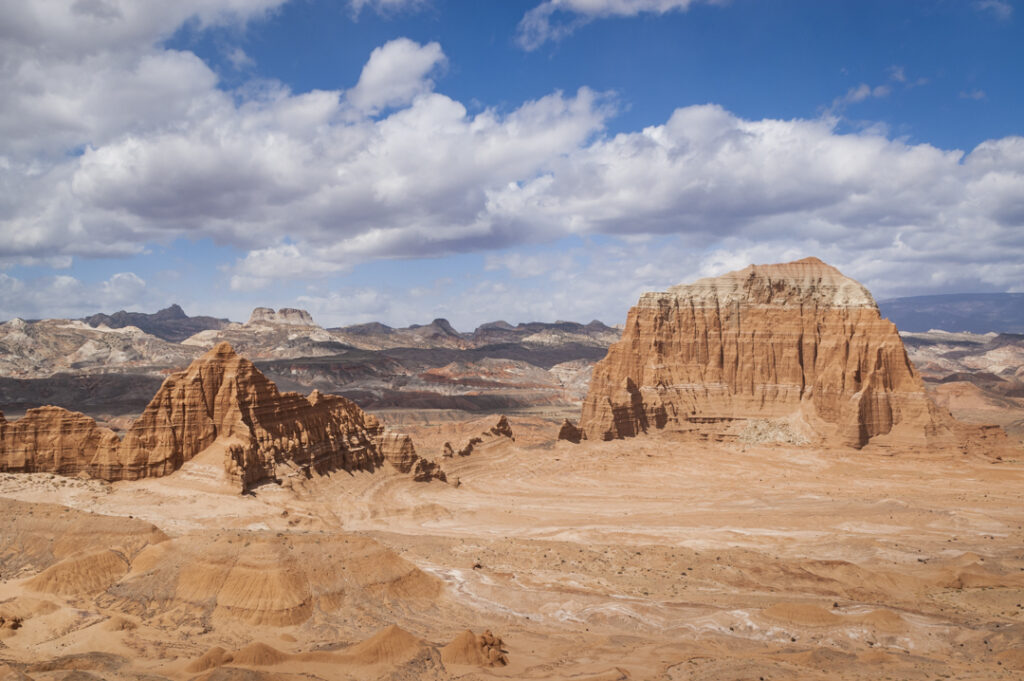
When people ask me my favorite of Utah’s Mighty 5 national parks, my response usually raises eyebrows. But Capitol Reef’s towering sandstone walls, bright cherry orchards, and dense canyon country are nothing short of spectacular.
We’ve put together the best itinerary for families and top-ropers alike to experience this hidden gem.
Where to Stay
Camp In The Park:
There are several camping options inside Capitol Reef National park. The Fruita campground is a wonderful and convenient location for tent and RV camping. It has running water and clean restrooms, is near the river, and next to the historic orchards. Reservations are required in advance between March 1 and October 31. Reservations are accepted 6 months ahead of time. It’s recommended to book well in advance. Off-season, the campground is first come first serve.
Alternatively, the park offers two no-fee primitive campgrounds. These are both first come first serve and have pit toilets but no running water. They offer great access to either Cathedral Valley or the southern parts of the park but are rather inconvenient for access to the Fruita area and most of Capitol Reef’s hikes. Be sure to check road conditions and requirements before camping in one of these sites.
Stay in Torrey
11 miles outside the park is the pleasant town of Torrey, Utah. Torrey has many different options for hotels and three different RV parks. I personally lived at Sandcreek RV Park in Torrey for a summer and really enjoyed the experience. If you’re looking for nicer accommodations I highly recommend The Lodge at Red River Ranch.
Dispersed Camp on BLM
If you are interested in dispersed camping there are free dispersed camping locations to both the east and west of Capitol Reef along highway 24. Be sure you understand BLM dispersed camping regulations before choosing this method.
Places to Eat
There are no restaurants or cafes inside Capitol Reef National park. The only food available in the park are snacks at the visitor center, fruit picked from the orchard, and pies sold at the Gifford Homestead.
Your best bet is to pack meals to bring with you into the park. While Torrey has a very small (and expensive) grocery store in town called Austin’s Chuck Wagon, the nearest true grocery store is in Loa, 28 miles outside the park.
Torrey has a number of restaurants available. We highly recommend checking out Capitol Burger food truck. It is in the top 3 burgers I have ever had. Be sure to check out their Facebook page to see what days they are in Torrey.
If you are coming from the East then Hanksville is your last stop for food before getting to the park. Hanksville has a very small grocery store and Stan’s Burger Shake is a great place for a burger and shake.
When to Go
Capitol Reef can be visited in each season with pros and cons to each. Regardless of the season, there is always great appeal to visitors.
There is no “best” time to visit Capitol Reef National Park. When to visit really depends on the sort of experience you are looking to have.
For this itinerary, we are assuming you are visiting during the summer.
Capitol reef is most accessible in Spring and Fall, when temperatures are mild and the orchards have flowers and fruit, respectively. May and September are the park’s busiest months.
Winter seldom brings snow and is trafficked least.
For the purpose of this guide, we will focus on the most popular season to visit, summer.
Like the rest of southern Utah, the summers are very hot and exposed. We highly recommend finishing all of your hiking by noon and getting in the shade or indoors until it cools down in the evening. Heatstroke is no joke!
Possible Hazards
“Know Before You Go” is an important motto for visiting Capitol Reef National Park. We have encountered rattlesnakes just feet away from us, unknowingly touched lethal plants, been in a slot Canyon during a rainstorm, and been out in the sun much too late into the day.
Learn from our mistakes and review the safety tips for visiting the park.
A few things to consider:
Rattlesnakes: Capitol Reef is home to the faded-midget rattlesnake. Always be sure to look where you are stepping and do not put hands or feet into areas you cannot see.
Heat Stroke: Heat stroke is a life-threatening condition. If visiting in the summer avoid hiking during the heat of the day (We try to stop hiking no later than 12:00 PM). Be sure to always have sufficient water and eat salty snacks to prevent hyponatremia.
Flash Floods: Always be aware of the weather. Especially during monsoon season and in slot canyons. Remember that it can flood where you are even if it’s raining miles away.
Plants: There are many poky plants in Capitol Reef and even some toxic plants.
ADA Opportunities
Unfortunately, Capitol Reef offers few ADA opportunities. However, there are still some areas of the park that are accessible and worth seeing. You can see the park’s full list here and some suggestions below.
- The Fremont Culture petroglyphs are an amazing sight and have a wonderful and shaded boardwalk that is accessible. In the summer there are daily ranger talks at the petroglyphs.
- The Fruita Campground has 5 accessible camping spots and is a beautiful place to spend time.
- Overlooks throughout the park are accessible.
- If you are able to ride a horse there are several horse tour options out of Torrey
- Sleeping Rainbow Adventures is an awesome tour company out of Torrey that is happy to facilitate tours for people with physical disabilities. One of the owners is a friend and former Capitol Reef employee and a really neat person.
Three Day Itinerary
Day 1 – Morning
Goosenecks
If you are staying in Torrey then Goosenecks is a fantastic first introduction to Capitol Reef National Park. It’s sort of like a teaser for what is to come. Goosenecks is a .01 miles hike to an outstanding canyon view from which you can see the lowest rock layer of Capitol Reef. Take a good look, you might find yourself (safely) hiking along that creek later on!
Alternative:
If you’re coming from the east side of the park or staying in the park this is a great opportunity to check out the awesome visitor center and their huge 3D map. Want to see the whole “Waater Pocket Fold?” This is a great space to see it. You are also welcome to drive up to the Goosenecks overlook, it’s your trip overall!
10:00 AM Geology Talk
Believe me, you don’t want to skip this. Capitol Reef is, among other things, a geology park. And by learning a bit about how the geology was formed and what to look out for while in the park you can have a ton of fun and gain a lot of appreciation. Seeing cool rocks is one thing, knowing what layers of rock are in a towering cliff and why they are so colorful is a whole other.
Capitol Reef has daily geology talks at 10:00 in front of the visitor center, you won’t want to miss it!
Drive down to Capitol George and tanks
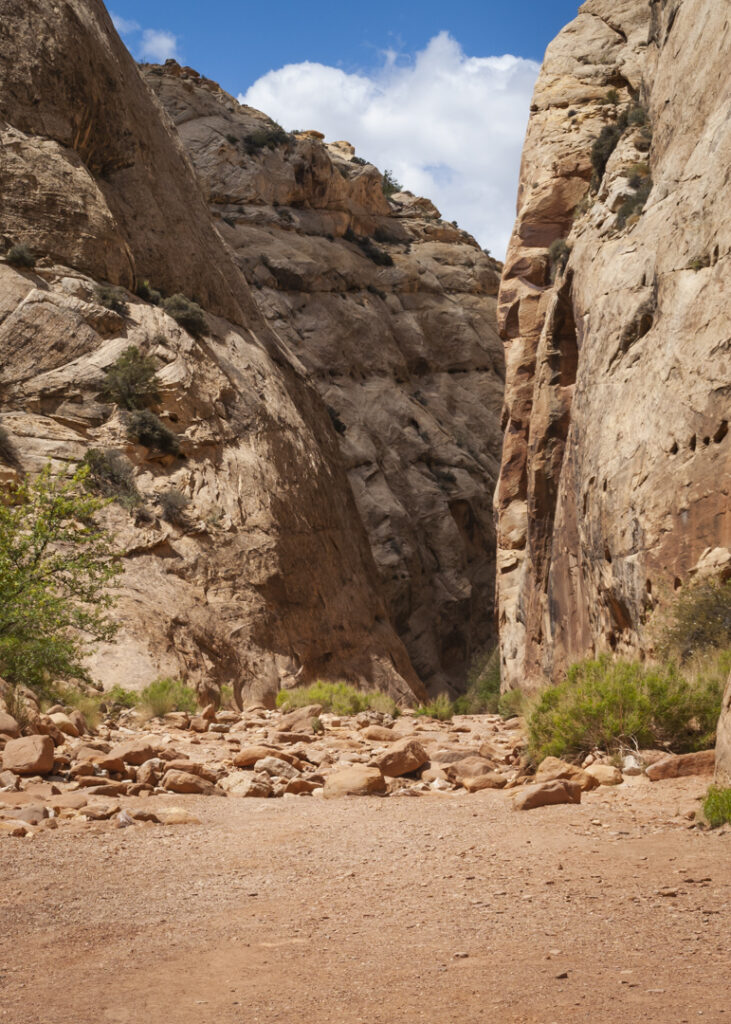
Following an awesome primer on geology, it’s time to check out some of that unique geology in person!
Capitol Gorge is one of our favorite hikes in the park. Walk along this deep sandy canyon where you can see petroglyphs, huge red rock walls, and maybe even bighorn sheep (it’s one of the best places in the park to see them)!
If you’re in for just a tad of elevation you can also climb to the “tanks” which are deep holes in the rock often filled with water, even in summer. Continue on further than the 1 mile and you can even hike to the park boundary.
Fun Fact:
Though you can’t tell at all today, Capitol Gorge was the road through Capitol Reef National Park before the current highway was built in the 1970s! There is even an old rusted and buried car at the very end of the gorge.
Day 1 – Afternoon
Eat lunch
Post-hike lunch is awesome, and this is a great time to eat some. There are shaded picnic tables at the trailhead of Capitol Gorge, so you can grab your lunch from your car and eat with a view.
Relax until evening because it’s hot
Remember how we mentioned how it gets insanely hot in the afternoon? Well, that’s a great time to slow down and avoid getting heatstroke.
Here are a few ideas of what you can do to spend your afternoon. I don’t recommend getting back out until the evening.
Visit the Ripple Rock Nature Center (open during summer)
The Ripple Rock Nature Center is an awesome activity center in one of the park’s orchards. It is mainly geared towards kids but is honestly very fun for adults too (believe me, I was in charge of the center for a summer). In the afternoon they have a geology talk geared towards kids. They have a variety of activities in the center and even activity bags that you can check out. Plus it’s less crowded and the staff member there can answer almost any question you have.
Pick Some Fruit
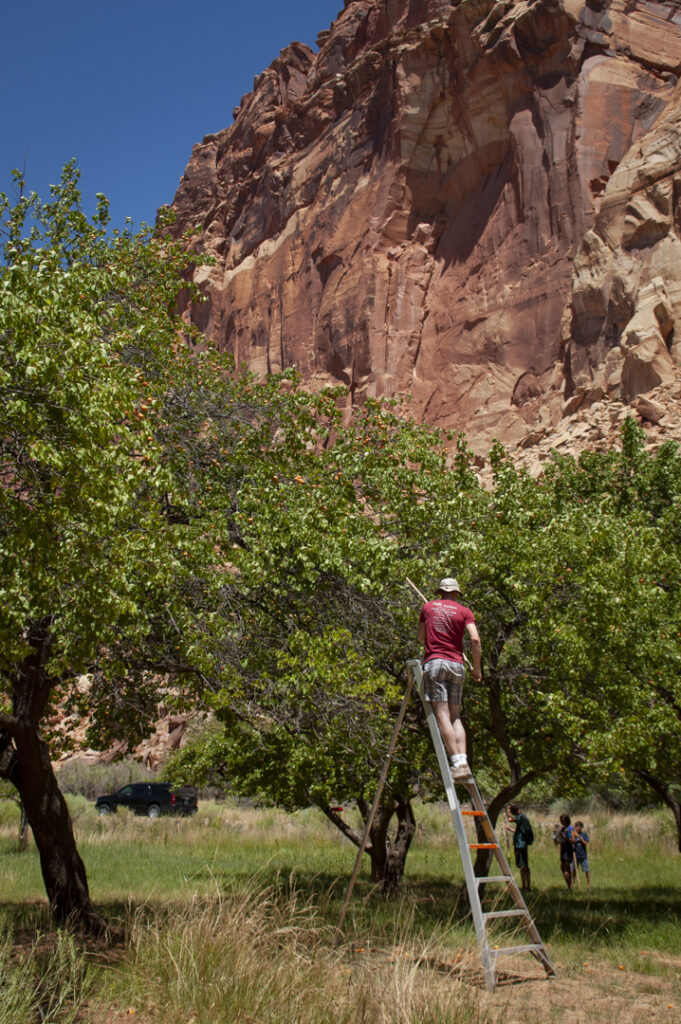
If it’s too hot for hiking but still somewhat bearable you could spend some time picking fruit or relaxing in the orchards.
Relax
You’re on a trip, take a break! National parks are an awesome place to just kick back and relax. Read a book in the picnic area, take a nap in your tent, or sit in the shade and draw. I am giving you permission to slow down and relax when it’s too hot to have much fun anyway.
Day 1 – Evening
Hickman Bridge
Come evening time (after 6) the weather starts being more pleasant and it’s a great opportunity to head out for some more exploring.
Hickman Bridge is Capitol Reef’s most popular trail and the perfect evening hike. It’s a little less crowded in the evening and makes for a very pleasant stroll with amazing things to see. Besides a large stone arch, you can also see a Hisatsinom pit house, plants, flowers, and some amazing-looking geology. I highly recommend getting the trail guide at the start of the talk.
Ranger Talk
Evening ranger talks at national parks are amazing. At Capitol Reef they are different every night and can be on a whole range of topics such as mountain lions, women’s history in the park, water in the desert, and more. They are a great way to finish off the evening and you won’t want to miss out.
If your lucky you might even be able to see one of the artists in residence speak (or play the saxophone as I once saw!).
The start times and topics can be found posted throughout the park.
Day 2 – Morning
Sulpher Creek
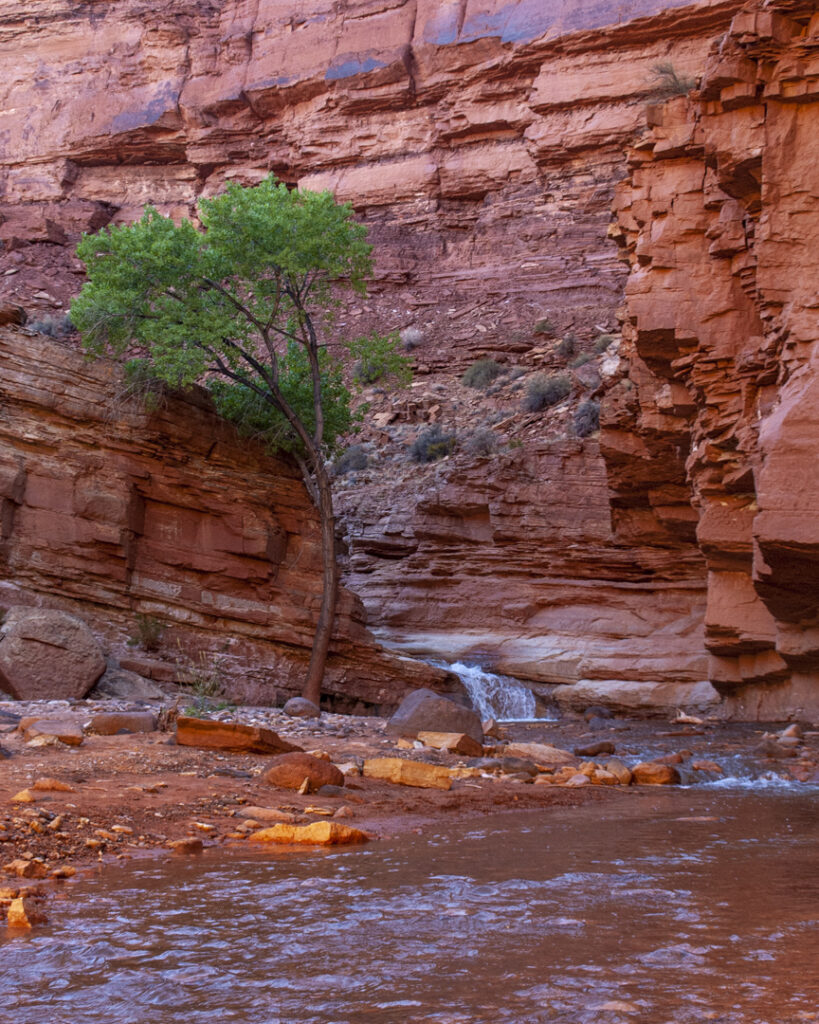
Utah is Canyon Country, and there is nothing quite like hiking down a deep canyon through a creek.
Sulpher creek is one of the coolest hikes in Capitol Reef, both in how fun it is and the temperature.
This is a 5.8-mile hike with plenty of shade, waterfalls, and fun.
The official start for this hike at the parking lot that is .3 miles West of the Chimney Rock Parking lot. Since it is a one-way hike you will either need to have two cars to shuttle, or hitch hike back to the parking lot. Alternatively, you can start the hike in the creek behind the visitor center and turn around whenever you want so there is no need to make it back to the car.
We recommend checking out the National Park’s guide for the hike.
Warning! Be sure to never hike in canyons on days with the potential of rain, this is a fundamental safety tip of Canyon country.
Day 2 – Afternoon
Lunch
After an awesome morning hike you could swing by the park’s picnic area to eat your lunch. While you’re there you could also try one of the locally made pies at the Gifford House.
Petroglyph Talk/Relax
After lunch, you could relax and check out one of the activities listed in day one.
If your willing to be in the sun for a little you could also go over to the highway petroglyphs where there is a daily ranger talk about the petroglyphs and Hisatunam people who made Capital Reef their home.
Day 2 – Evening
Once it’s cooled down you could go out and explore the park some more and take a look at the stars.
Capitol Reef is an International Dark Sky Park, and has the best stars we have ever seen in our lives.
A few evening/night hikes you might consider: Chimney Rock, Fremont River, Sunset Point, or Grand Wash
On occasion during the summer there are also Nigh Sky themed ranger talks.
Day 3 – Morning
Day three is a sort of choosing your own adventure depending on what kind of adventure you feel like taking on. We have three awesome ideas for you to choose from.
Hike some Slot Canyons

If you want some nice slot Canyons then check out Burro Wash, Cottonwood Wash, or Sheets Gulch Slot Canyons. Each Canyon is accessed from the Notom Bullfrog Basin Road. The visitor center has maps for these canyons at the front desk if you ask.
A caution: Don’t go into slot canyons if there is a chance of rain. I once hiked in Cottonwood Wash in the rain and it was one of the single most terrifying moments of my life.
Drive the Cathedral Valley Loop
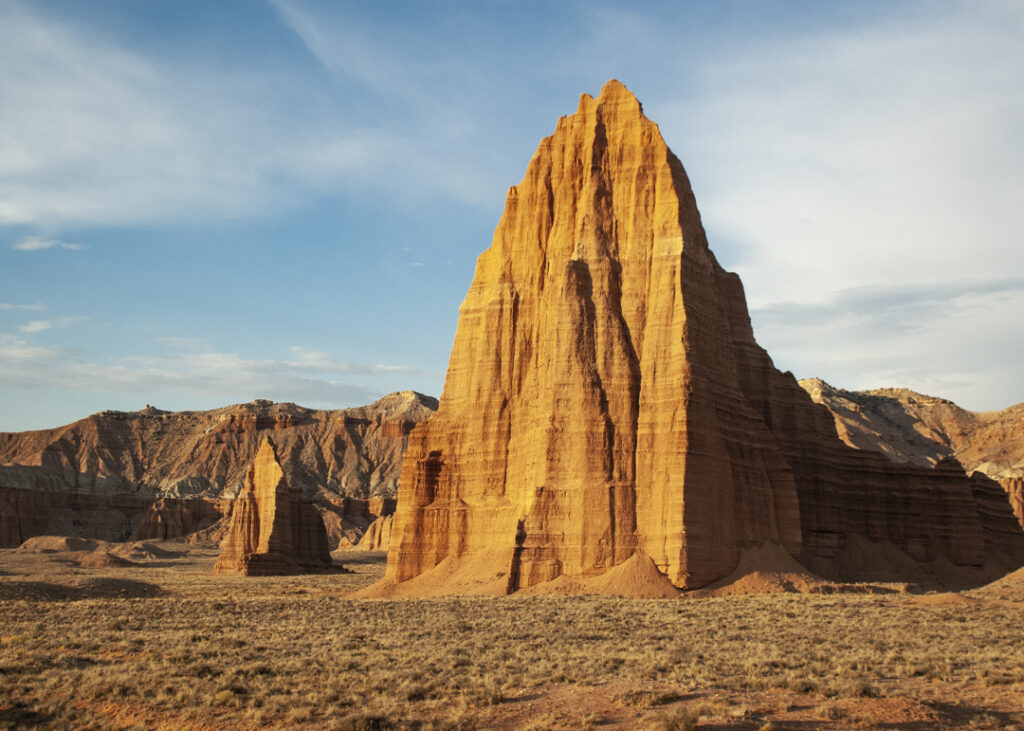
Cathedral Valley Loop is one of the most amazing drives in Utah, and if you don’t mind an all-day drive then Cathedral Loop Is a great all-day adventure.
Several tips:
Buy the Cathedral Loop guidebook from the Visitor Center. It cost about $2.50 and is 100% worth it. Without it you’ll miss a lot.
If doing the whole loop, make sure you have high clearance to cross the stream, ask about crossing depth by calling or visiting the visitor center. If you own something like a Subaru and the river is too high you can access the loop as an out-and-back from the eastern access road.
It is not recommended to go to Cathedral Valley during the summer monsoon season (July – September).
Hike the Cassidy Arch, Frying Pan, Cohab Canyon trail
This is an awesome hike made up of three trails where the Frying Pan connects Cassidy Arch to Cohab Canyon. It is about 5.6 miles and an awesome and unique Utah rock experience.
One of the highlights is that you can visit and walk across Cassidy Arch. Yes, you can walk across it.
Day 3 – Evening
If you find yourself looking for something more to do after a day full of adventure you can do any of the remaining front country hikes that may have sparked your interest, or perhaps another evening ranger talk!
Conclusion
Capitol Reef National Park is an amazing place to spend a day or several months.
However long you decide to stay in the Park we are sure you will find pleanty of amazing activities to do and we hope this guide helps!
Feel free to reach out to us at slowtheparks@gmail.com and let us know how your stay in Capitol Reef went! We would love to hear from you.
